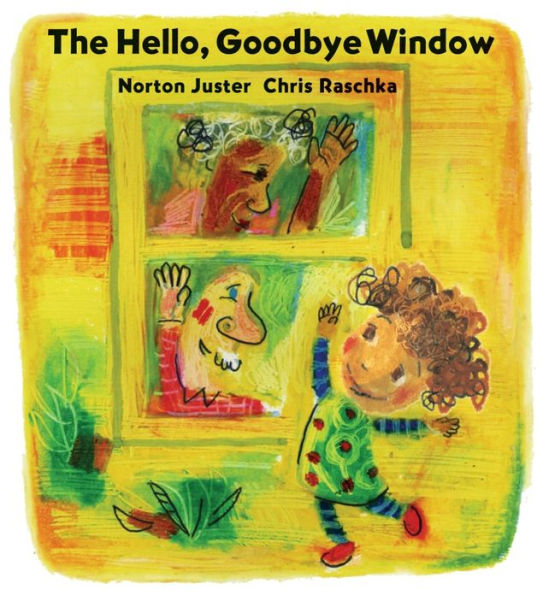In his first picture book, Phantom Tollbooth author Norton Juster joins forces with Chris Raschka for a top-notch tale filled with family-themed fun and lots of heart. Following a girl who goes to visit her grandparents, Juster’s soothing story centers around Nanna and Poppy’s “Hello, Goodbye Window” -- a portal into, and out of, their magical world, all brought to life by Raschka’s vibrantly colored, imaginative illustrations. No doubt, it’s a world you’ll want to visit, too.
This sweet slice-of-life pays homage to a loving grandparent-grandchild relationship. A little girl describes the everyday magic of time spent with her grandparents, insightfully using the kitchen window as a reference point because "the kitchen is where Nanna and Poppy are most of the time." Through it they greet the day, look at the stars, and blow kisses when saying good-bye. Both the wonder-filled text and the loose, impressionistic paintings are endearingly childlike, communicating a profound respect for the young. (ages 4 to 6)
Child magazine's Best Children's Book Awards 2005
Juster (The Phantom Tollbooth) crafts a cozy portrait of a grandchild and her grandparents in this endearing book, illustrated in paintbox colors by Raschka (Be Boy Buzz). A curly haired girl-who dances with wiggly energy in Raschka's lush paintings-describes playful visits to her Nanna and Poppy, whose kitchen window provides the perfect venue to say hello and goodbye. "You can climb up on the flower barrel and tap," she says, "then duck down and they won't know who did it." Her grandparents welcome her into a sunlit, spacious kitchen filled with plants, where she doodles and listens to Poppy play "Oh, Susannah" on the harmonica. At night, the "Hello, Goodbye Window" functions as a mirror, and the girl jokes about being outside looking in: "Poppy says, `What are you doing out there? You come right in and have your dinner.' And I say, `But I'm here with you, Poppy,' and then he looks at me in his funny way." Juster departs from the over-the-top punning of his earlier works to create a gently humorous account of a family's conversations and games, all centered on the special window. Raschka warms the pages with glowing yellow, emerald, sapphire and golden brown, and he pictures the garden and trees in emphatic midsummer greens. The characters smile at one another with a doting twinkle in their eyes, and grandparents especially will be charmed by this relaxed account of how a child's visit occasions everyday magic. Ages 2-up. (Apr.) Copyright 2005 Reed Business Information.
A young girl takes us to her Nanna and Poppy's house to see a very special window. Most of the time her Nanna and Poppy are there in the kitchen so she can tap on the window, then hide, or they can wave at her when she arrives. We share her joy in the fun she has with Poppy's harmonica playing, watching reflections in the window at supper, saying goodnight to the stars with Nanna, looking through the window at the garden, playing outside. Sometimes through the window she sees people; sometimes her imagination fills it with other more amazing sights. Saying goodbye through the window when Mommy and Daddy pick her up is sad, but she looks forward to having her own "Hello, Goodbye Window" some day. Raschka turns the pages into scenes of innocent joy. His paints barely suggest objects as he applies intuitive areas of color, he then uses black lines here and there to define a face, a bicycle, a spouting hose. The personalities of the grandparents and their loving interactions with the narrator make this an engaging tale, while the artist's imagination forms something special from a bit of childhood. 2005, Michael Di Capua Books/Hyperion Books for Children, Ages 3 to 6.
—Ken Marantz and Sylvia Marantz
PreS-Gr 1-The window in Nanna and Poppy's kitchen is no ordinary window-it is the place where love and magic happens. It's where the girl and her doting grandparents watch stars, play games, and, most importantly, say hello and goodbye. The first-person text is both simple and sophisticated, conjuring a perfectly child-centered world. Sentences such as "When I get tired I come in and take my nap and nothing happens until I get up" typify the girl's happy, imaginative world. While the language is bouncy and fun, it is the visual interpretation of this sweet story that sings. Using a bright rainbow palette of saturated color, Raschka's impressionistic, mixed-media illustrations portray a loving, mixed-race family. The artwork is at once lively and energetic, without crowding the story or the words on the page; the simple lines and squiggles of color suggest a child's own drawings, but this is the art of a masterful hand. Perfect for lap-sharing, this book will find favor with children and adults alike.-Angela J. Reynolds, Washington County Cooperative Library Services, Hillsboro, OR Copyright 2005 Reed Business Information.
On the title page, a little girl springs away from her parents; turn the page, and the reader sees only her arms on the gate, the reader taking her perspective as she looks over to the white clapboard house where her Nanna and Poppy's faces stare equally eagerly out of the Hello, Goodbye Window. The exuberant tot proceeds to spend a thoroughly idyllic overnight with her loving grandparents, the stay punctuated by a harmonica serenade, a bike ride ("Not in the street, please") and a nap. Juster adopts the voice of the child, whose present-tense narration is just right, describing pleasures (saying good night to the stars) and perils (the tiger at the back of the garden) with a steady, sweet candor. Raschka's mixed-media illustrations are characteristically loose and energetic, depicting this happy, biracial family with jewel tones and extravagant swirls. As the little girl unwinds at the end of the stay, she imagines the many possible visitors who might come to the Hello, Goodbye Window-but no one is more happily welcomed than her parents, who pick her up after her picture-perfect day. (Picture book. 3-7)








